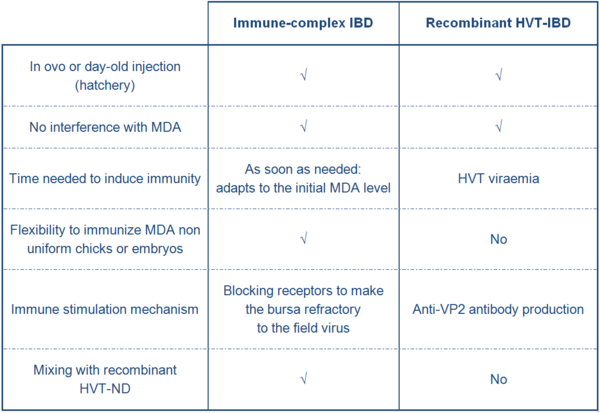...
-->Introduction
-->Conlusion
...
IBD IMMUNE-COMPLEX AND RECOMBINANT IBD CONCEPT IN HATCHERY
By Dr Christophe CAZABAN - Global Technical Services Manager, Ceva Santé Animale, France
.
Introduction
Infectious bursal disease (IBD, also called Gumboro disease) is one of the main causes of immunosuppression in chickens, which is translated into poor performances, higher feed costs, higher condemnation rates, and ultimately poorer profits. It is caused by a very resistant virus, called infectious bursal disease virus (IBDV). The disease is spread worldwide, including in South East Asia.
An economic survey of the consequences of a moderate IBD infection in broiler flocks was performed more than two decades ago in Western Europe: in case of infection, the return on investment at the end of rearing was damaged by 14% compared to non infected flocks (McIlroy et al., 1989).
That is why a sound prevention program must be put in place, in addition to a strict biosecurity policy.
.
Vaccination Strategy
Hatchery vaccination represents a dramatic improvement compared to the traditional vaccination in the farms, due to (Gardin 2008):
- A better consistency of vaccination quality thanks to state-of-the-art equipment that can be calibrated, adjusted, and regularly checked;
- An easier management of a limited staff in one given place (through training, incentives and audits), compared to dozens of spread out farmers;
- Less stress to the birds: one injection of several products either at hatch or in ovo, instead of using water withdrawal under heavy climate conditions in later ages;
- The availability of innovative technologies that enable to vaccinate even in the presence of maternally-derived antibodies (MDA); indeed, the MDA directed against IBDV are also strongly neutralizing classical live attenuated vaccines if given too early.
New technology vaccines are now available. They enable hatchery administration and they stand the interference with MDA. One can identify two types: immune-complex and live recombinant (HVT vectored) vaccines. Several commercial vaccines of each category are available today on the market; they are supplied by different international pharmaceutical companies.
.
Immune Complex Technology
The immune complex technology is using the association of the IBD vaccine virus to specific antibodies in well defined proportions: “immune complex”. Basically, such vaccines are able to induce the release, and hence the replication, of the vaccine virus in the chicken’s body at a time where MDAs have reached a level that is no longer capable to neutralize it. A full vaccine virus is therefore strongly stimulating the immunity at the right time for every single chick. The higher the MDA level at hatch, the later the release; the lower the MDA level at hatch, the sooner the release.
.
Recombinant Technology
Live recombinant IBD vaccines are using another virus as carrier of relevant IBDV proteins that are stimulating the immunity. As far as IBDV is concerned, a surface protein called VP2 is considered as the most important in inducing protective immunity. Scientists are now able to extract the corresponding gene from IBDV genome and to insert it into another virus. The rationale is to stop using a whole IBD virus to stimulate immunity against IBD. Instead, a virus called HVT (which stands for Herpes Virus of Turkey) is used to carry the IBDV VP2 protein on its surface. The main asset is the ability to present the vaccine in a cell-associated form, in liquid nitrogen tanks. This pharmaceutical presentation is a way to avoid neutralization by MDA. The way these vaccines induce protection still needs further research work to be done until we actually fully understand it. Certainly, the stimulation of immunity depends upon the kinetics of HVT virus which needs several cycles of viremia before inducing a significant protection.
.
How to Choose?
The two types of vaccines are of premium standard in terms of sterility, since they must be injected. They also show very satisfactory safety features, as evidenced by billions of doses of each that are used worldwide every year.
As far as efficacy and protection against infection are concerned, several experiments in controlled conditions as well as in the field have demonstrated a better consistency, reliability and strength of bursa protection when using immune-complex compared to recombinant vaccines (Penzes et al., 2008; Sesti et al., 2011). This is probably linked with:
- The adaptation of the immune complex to the actual MDA status of every single chick at hatch;
- The occupancy of bursa receptors by the vaccine virus after release from the immune complex; by this way, the field virus is completely unable to infect the chicken.
.
Conlusion
As a summary, the main features of each technology are recapitulated in this table.
.
(Source: "Axis Magazine - Poultry” - VIV Asia 2013 Edition)

 Corporate Website
Corporate Website
 Africa
Africa
 Argentina
Argentina
 Asia
Asia
 Australia
Australia
 Belgium
Belgium
 Brazil
Brazil
 Bulgaria
Bulgaria
 Canada (EN)
Canada (EN)
 Chile
Chile
 China
China
 Colombia
Colombia
 Denmark
Denmark
 Egypt
Egypt
 France
France
 Germany
Germany
 Greece
Greece
 Hungary
Hungary
 Indonesia
Indonesia
 Italia
Italia
 India
India
 Japan
Japan
 Korea
Korea
 Malaysia
Malaysia
 Mexico
Mexico
 Middle East
Middle East
 Netherlands
Netherlands
 Peru
Peru
 Philippines
Philippines
 Poland
Poland
 Portugal
Portugal
 Romania
Romania
 Russia
Russia
 South Africa
South Africa
 Spain
Spain
 Sweden
Sweden
 Thailand
Thailand
 Tunisia
Tunisia
 Turkey
Turkey
 Ukraine
Ukraine
 United Kingdom
United Kingdom
 USA
USA
 Vietnam
Vietnam







